Green Lantern #63 (DC Comics, $2.99)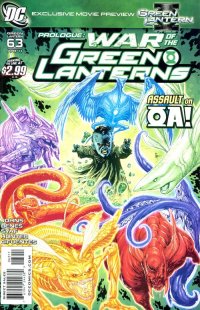
by Graig Kent
Here it is: the Prologue to “The War of the Green Lanterns”, and I want to dismiss it. I want to say it’s excessive and unnecessary and Geoff Johns really needs to stop with the all-too frequent barrage of Green Lantern-related mega-stories (the Sinestro Corps War, Blackest Night, Brightest Day) and their sprawl into the DCU at large. I want to say that I’m done with Lanterns, especially after the last few months of a somewhat stagnant Green Lantern series that’s only kept me interested because of some gorgeous art from Doug Mahnke. I want to be jaded and think that it’s just a shameless event put together solely to coincide with the forthcoming live-action movie. I want to do all that. But I can’t.
Truth is, I always seem to underestimate Geoff Johns and his ability to plan a story. Despite thoroughly enjoying the Sinestro Corps War and Blackest Night, I still seem to fall back on the default opinion that Johns’ affection for the Silver Age is ultimately detrimental to the progress of the DCU and remain skeptical of his abilities and intentions. This issue, which features art from Ed Benes and Adrian Syaf in place of Doug Mahnke, is a definite step down in the pretty department, so there’s one strike against this “War of the Green Lanterns” right out the gate. But without getting nitpicky, that’s the worst I can say of it. Johns has won me over, yet again, with his mythology building, here centering around the rogue Guardian Kronos. Through this myth-making we’re beginning to learn the origins of the lanterns, and not just the Green Lantern Corps, but all of the lanterns on the emotional spectrum. We’re also perhaps bearing witness to the vilification of the Guardians of the Universe, who are maybe not as benevolent and altruistic as they seem. Dictatorial, Orwellian could be more fitting descriptions. We’ll wait and see.
“The War of the Green Lanterns”, I presume, has to do with Hal Jordan’s defiance of the Guardians, and will ultimately wind up with the entire Corps deciding between loyalty to the Guardians or aligning with Hal. I have to say that I’m pleased that this one, for a change, seems like it’s much more contained to the Green Lantern realm, intending to have a very specific payoff for the characters within it. It’s also bringing to a head the events of the past few months, and moreso the past few years, and while it not be as broadly reaching as Blackest Night, it’s carrying on in the same scope and perhaps with even more at stake for the main characters of the various Green Lantern series. So it’s more of a “fans only” event, but it should prove to be entertaining.
Rating: 




Out of a Possible 5 Stars
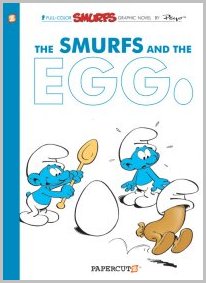 The Smurfs and the Egg (Papercutz, $5.99)
The Smurfs and the Egg (Papercutz, $5.99)
By Adam Prosser
I sometimes picture a meeting taking place in a dimly-lit room—maybe some little-used corner of the Batcave—between various comic book characters. It’s a support group. Howard the Duck is the group leader. The League of Extraordinary Gentlemen, and a host of other Alan Moore characters, fill the seats. Jonah Hex has just joined. Captain America’s been there since the 80s, but he’s thinking he might not need to come to these meetings anymore. Frank Castle keeps leaving and coming back.
They meet every Friday, share coffee and commiserate. And once a meeting, you’re sure to hear some variation on the phrase: “The comic was good. Honest.”
I’m not sure if the Smurfs are attending these meetings yet, but brother, if this is any indication, they’ll soon need the support that only fictional characters who have been in their situation can provide.
North Americans of my generation know the Smurfs mostly for their fairly mediocre cartoon show of the 80s, which has survived in the public consciousness only because EVERY cartoon show of the 80s has apparently been elevated to the level of nostalgic fetish. But long before that, the Smurfs were a Belgian comic called Les Schtroumpfs, written and drawn by Pierre “Peyo” Culliford, spun off of his comic Johan et Pirlouit, a comedic take on Prince Valiant. Created in 1958, the Smurfs were reprinted in the classic slender hardcovers which are standard for a lot of European comics (if you’re familiar with Asterix or Tintin, you’ll know what I’m talking about) in both French and English. They were a staple of my childhood libraries here in Canada, but it’s possible that they aren’t as well known in America, or to kids of the last 20 years or so.
In the lead up to the (sigh) movie, though, Papercutz has been reissuing paperback translations of the original Smurfs comics, so hopefully a new generation of kids can experience just how delightful they are. In this latest, 5th collection, the Smurfs stumble upon a magic egg that grants wishes, with bizarre results; their archnemesis Gargamel transforms himself into a Smurf to infiltrate the village; and Vanity Smurf’s reflection comes to life. As you might be able to tell, the series is pure fairy tale, with magical stuff often happening with little or no explanation, and the nonsense is increased by the smurfs’ tendency to speak “smurfish”, which is to say, replacing every other word with “smurf”. Unlike the cartoon, there’s also very little attempt to differentiate the individual smurfs, apart from Papa, which ought to be a strike against it but somehow just makes everything more delightfully weird (I won’t go into the smurfs-as-metaphor-for-communism discussion here, but rest assured, it’s a common interpretation of the series). Peyo’s art is expressive, detailed, and appealing (again, the resemblance to Asterix is strong) but I do have to dock this collection a bit for the English translation—earlier editions tended to feature wittier dialogue, whereas this collection is a little flatter and more straightforward.
In the end, as annoying as it is to see our favourite comics get butchered on screen, movies can help draw attention to the original works, if they’re marketed cannily, and Papercutz is doing a great job of this. So just ignore the “Smurfs movie” inset on the front and enjoy some classic comics, or pass them along to the budding comics enthusiast of your choice. If at all possible…before the movie comes out.
Rating: 




Out of a Possible 5 Stars
Axe Cop: Bad Guy Earth #1 (Dark Horse, $3.50)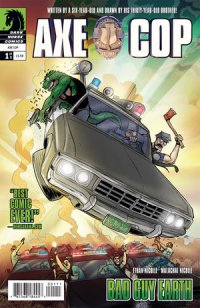
By Adam Prosser
“Outsider Art” refers to artwork produced by someone who not only is not a professional artist, but has as little understanding as possible of the technical principles of art. It’s often seen as an example of a mean-spirited, elitist tendency amongst art afficianados, or else as an example of how out-of-touch they are; I can think of dozens of humour comics that use some variation on “the hero is acclaimed as an artistic genius without trying” as their basic plot. And it is true that outsider art can have an exploitative feel to it. But it can also be tremendously illuminating to study art produced by people who have no idea of what the boundaries of what constitutes “art” is supposed to be, and that’s not even considering that the art may be straightforwardly entertaining or beautiful in and of itself.
Axe Cop seems like a perfect example of how Outsider Art can stimulate, entertain, and just generally be employed in a positive way. If you’re somehow unfamiliar with the Axe Cop phenomenon, it’s a webcomic written by a 6-year old, Malachai Nicolle, and drawn by his 30-year-old brother, professional artist Ethan Nicolle. The premise isn’t any more complex than “A cop who finds an axe and uses it to fight crime”, but, as anyone who’s ever listened to a small child tell a story could predict, the narrative very quickly spins off in a hundred goofy directions involving dinosaurs, a mad scientist with a unicorn horn, superheroes with socks for arms, and telepathic dogs from outer space.
This original 3-part miniseries is essentially “more of the same”, though it does give us a more detailed look at Axe Cop’s origins (he went to Axe Cop Academy, where he read a book on How To Be a Cop With an Axe…obviously) and sets up an epic tale in which Axe Cop runs afoul of the law for breaking the Cop Rules (one of which is “Cops don’t use an axe!” and another of which is “no traveling from one planet to another planet.”) By the end of this issue, the very fate of Earth hangs in the balance.
The central joke is the deadpan professionalism with which Ethan renders Malachai’s ideas. It’s funny without being mean; I suppose you could see it as mockery, but anyone who has a child, or in this case a younger sibling, will recognize the obvious admiration Ethan has for his brother, and the whole comic is clearly a labour of love, in every sense. As for the reader, once you’re done laughing at the weirdness on display, you can marvel at the birth of a new creative talent. Or are we all this creative at that age? How soon we forget.
Rating: 




Out of a Possible 5 Stars
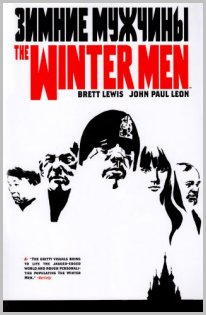 The Winter Men TP (Wildstorm Comics, $19.99)
The Winter Men TP (Wildstorm Comics, $19.99)
By Devon Sanders
We’re up in our necks in it. Editorially mandated superhero crossover engines. I hear it everyday, “I wish there were something different out there.” If wishes were as… Anyway. There’s tons of “something different” out “there.” We simply must be curious enough to look for it. Brave enough to give it a chance. If I told you about a smart “superhero” story with rich dialogue with characters who’ll make you flinch with nearly every decision and action, would you buy it? If I told you about a series lushly illustrated by one of comics’ most undervalued draftsmen, would you want in? Are you willing to read something that will make you wish there were more books like it? Then, you’re ready for The Winter Men.
In Moscow, its superheroes have come crashing down to Earth. The Winter Men focuses mostly on Kris Kalenov, ex-“superhero,” rough and aimless, tasked with maintaining the shades cast over the people by the local Mafiya. He’s had it and just wants to feel something other than disappointed. With nothing left to lose, he takes the job of retrieving a young girl, bringing him into direct contact with his former allies, ex-Spetsnaz, The Winter Men.
Writer Brett Lewis has crafted a story where, quite frankly, the plot itself is rendered secondary to the storyline. The event that sets The Winter Men into motion is almost forgotten by the time its revisited. Here’s the interesting thing though, by then, you’re so invested/entertained by the characters, pacing and whip-smart dialogue that you simply don’t even dwell on the impetus of this whole thing. You’re too busy enjoying the book, as a whole. Lewis gives each Winter Man a reason for being within this story and as it closes, if you’re anything like me, you’ll wish you had more time with these characters.
Drawing all of this is John Paul Leon, each panel brims with just the right amount of information. Leon’s every line is considered and perfectly in tune with the script’s needs. Leon is simply, a fine designer and if you’re a fan of what’s beautiful, do yourself a favor and pick up The Winter Men.
The Winter Men TP is an incredible piece of fiction, one I’d readily recommend to any fan of Watchmen or V For Vendetta or ready for something truly good and different.
Rating: 




Out of a Possible 5 Stars
Marvel Zombies Supreme #1 of 5 (Marvel, $3.99)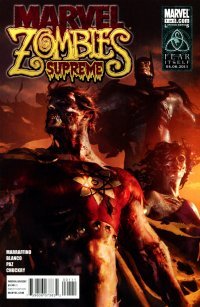
By Jeb D.
Well, now the whole “Marvel Zombies versus Darkest Night- who’s riffing on/ripping off who” debate goes all meta as the Marvel Zombie phenomenon expands to include the Squadron Supreme.
Honestly, that’s practically the entire review. Our nominal protagonists are a Special Ops unit that, Doom-like (the video game, not the Latverian monarch), are investigating an alarm at a top-secret high-tech scientific facility. They throw around a lot of video-game level military banter, make their way into the nearly impregnable facility, and find a terrified team of scientists… and the titular living super-dead. Complications ensue.
Writer Frank Marraffino touches all the appropriate bases, building to the introduction of the decrepit heroes, and artist Fernando Blanco certainly does a good job of striking the right balance between familiar characteristics and the obligatory entrails and rotting body parts. He also adds the book’s one distinctive touch: the charmingly cheesy Silver Age stylings of the flashback sequence detailing the spread of the zombie virus into the Squadronverse.
Sort of short and sweet, I guess: if you still find entertainment value in the whole super-zombies concept, and you’d like to see the brain-munching versions of Hyperion, Nighthawk, and Zarda, this is the book for you.
Rating: 




Out of a Possible 5 Stars
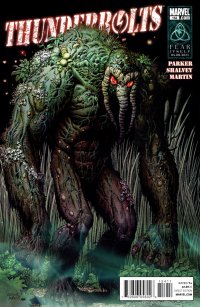 Thunderbolts #154 (Marvel, $2.99)
Thunderbolts #154 (Marvel, $2.99)
By Jeb D.
At the height of the Civil War/Dark Reign period, the revived Thunderbolts was, in the hands of writers like Warren Ellis, Christos Gage, and Andy Diggle, one of Marvel’s most consistently entertaining series, a study in spandex realpolitik with plenty of black humor and soap opera interpersonal dynamics. In the current era (which may or may not still be The Heroic Age; I lose track easily), it feels like a book looking for its place.
The decision to put Luke Cage at the head of the team is certainly in keeping with the post-Norman Osborn environment, but it suffers from the inherent blandness of the character’s treatment: Cage’s place in the Marvel U is a tough-talking teddy bear with a marshmallow heart; he’s rarely allowed to be the true badass he talks and acts like, and more than in any of his other appearances, this book reigns in what personality he does have. Luke’s at his best in opposition to authority, not exercising it, and while he’s strong enough to be reasonably placed at the head of a group of barely-restrained supervillians, he’s much less interesting in the role.
Jeff Parker is generally one of my favorite writers, but it feels as though he’s really reaching with this one. Man-Thing (who gets over-explained to death yet again in this book) is using his magical abilities to transport the Thunderbolts around like a slimy Scoobie-mobile, and this is NOT the way that the hidebound beauracracy wants to see things done! But when there’s weird swamp savages riding on ravenous man-eating lizards, it’s Man-Thing to the rescue. And those who know fear… well you know what THEY do at the Man-Thing’s touch. And won’t those darn beaureaucrats feel stupid when they’re shown the error of their ways!
Artist Declan Shalvey gives the swampy doings a nice rough texture (and the weird savages do look appropriately freaky), but a Thunderbolts comic that’s mostly about learning to play nice with those that are different from us is a far cry from the nastiness and paranoia that Ellis brought to the series’ revival, and which I’d like to see make a return.
Rating: 




Out of a Possible 5 Stars